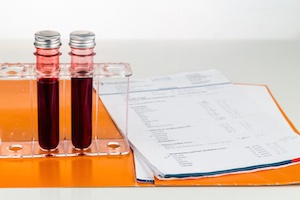
It is a biological fact that a woman is born with all the eggs she is ever going to have. As a woman ages, the number of eggs that are available decreases and the incidence of eggs with abnormal chromosomes (aneuploidy) increases. Consequently, older women have lower fertility and greater risk for miscarriage than younger women. “Ovarian reserve” generally describes the size, quality, and developmental potential of the remaining eggs in the ovary(ies).
Diminished ovarian reserve (DOR) is a common cause of infertility where the "quality" and/ or "quantity" of the woman's eggs is compromised. There are various tests for assessing "ovarian reserve" and these often correlate with success rates of treatments for infertility, independent of patient age, and provide important information for counseling and treatment planning.
Here are some important facts about DOR and ovarian reserve tests.
In some women, ovarian reserve and fertility decrease prematurely, at an earlier than expected age. Predisposing factors include smoking, chemotherapy, radiation, and ovarian surgery. Some women appear to have a genetic predisposition, suggested by their mother’s or their sister’s early menopause, but no cause can be identified for most.
Decreasing cycle length has long been recognized as one of the earliest indications of reproductive aging, but most young women with diminished ovarian reserve notice no change in their menstrual pattern.
As age and the pace of follicular depletion increase, serum follicle-stimulating hormone (FSH) concentrations rise progressively, most noticeably in the first few days of the menstrual cycle. Rising FSH levels, in turn, stimulate earlier advanced follicular development and earlier selection of the dominant follicle, resulting in a shorter follicular phase and higher estradiol levels early in the cycle. Age-related changes in the endocrine characteristics of the cycle correlate with a decrease in ovarian volume as well as the number of small antral follicles. Collectively, these observations provide the foundation for the most commonly used clinical measures of ovarian reserve, all intended to predict fecundity or to assess the prognosis for successful treatment in infertile women.
The FSH concentration, ideally obtained on cycle day 2, 3, or 4, is the simplest and most common “ovarian reserve test.” FSH values greater than 10–15 IU/L are viewed as suggesting diminished ovarian reserve.
The serum estradiol concentration, obtained at the same time, may provide additional information as elevated levels (> 75–80 pg/mL) may lower FSH concentrations below values that would otherwise suggest diminished ovarian reserve.
The clomiphene challenge test (CCCT) adds a provocative element to ovarian reserve testing by measuring the serum FSH level again on cycle day 10 after treatment with clomiphene citrate (100 mg/day) on cycle days 5–9. An abnormally elevated basal (cycle day 2–4) FSH or estradiol concentration or stimulated (cycle day 10) FSH level (> 10–15 IU/L) suggests a DOR.
Other proposed but less commonly used hormonal indicators of DOR include a low serum anti-müllerian hormone (AMH) or inhibin B level, and a poor estradiol response to FSH injections or gonadotropin-releasing hormone (GnRH) agonist stimulation. We use AMH levels in our practice and like them to be at least > 0.6 ng/mL. For our anonymous donor egg program, we like potential donors to have an AMH level > 1.5 ng/mL.
Ultrasonographic indicators of DOR include a decreased ovarian volume or antral follicle count, and reduced ovarian stromal vascularity. It is generally accepted that the "normal" ovarian volume is > 3 cc and there should be at least 3 - 4 antral follicles in each ovary.
Ovarian reserve tests have only modest predictive value. Test results have some value for predicting ovarian response to stimulation with fertility drugs (gonadotropins) and may therefore help in planning treatment. However, the accuracy of ovarian reserve tests for predicting pregnancy with treatment, including the assisted reproductive technologies (ART), is more limited, particularly in younger women.
Although an abnormal ovarian reserve test result may suggest a decreased probability of success, it cannot and does not predict certain failure. Therefore, test results should be interpreted, explained, and applied with caution and compassion.
Ovarian reserve tests do provide valuable information for counseling, particularly when considering more complicated, invasive, and costly treatments like ART. Moreover, other prognostic indicators such as age and previous fertility or response to gonadotropin stimulation have equal or greater relevance and predictive value. Women with mildly abnormal ovarian reserve test results may indeed have a lower probability for successful treatment, and should be so counseled, but they are not sterile.
When not grossly abnormal, ovarian reserve tests should not be the sole basis for denying treatment or for recommending the use of donor eggs.
Infertility Infertility treatment InVia Fertility Specialists Top 10

Dr. Karande is Board Certified in the specialty of Obstetrics and Gynecology as well as the subspecialty of Reproductive Endocrinology and Infertility. He is a Fellow of the American College of Obstetricians and Gynecologists and Member of the American Society for Reproductive Medicine.
Subscribe to our weekly blog digest

Entire Website © 2003 - 2020
Karande and Associates d/b/a InVia
Fertility Specialists

Comments